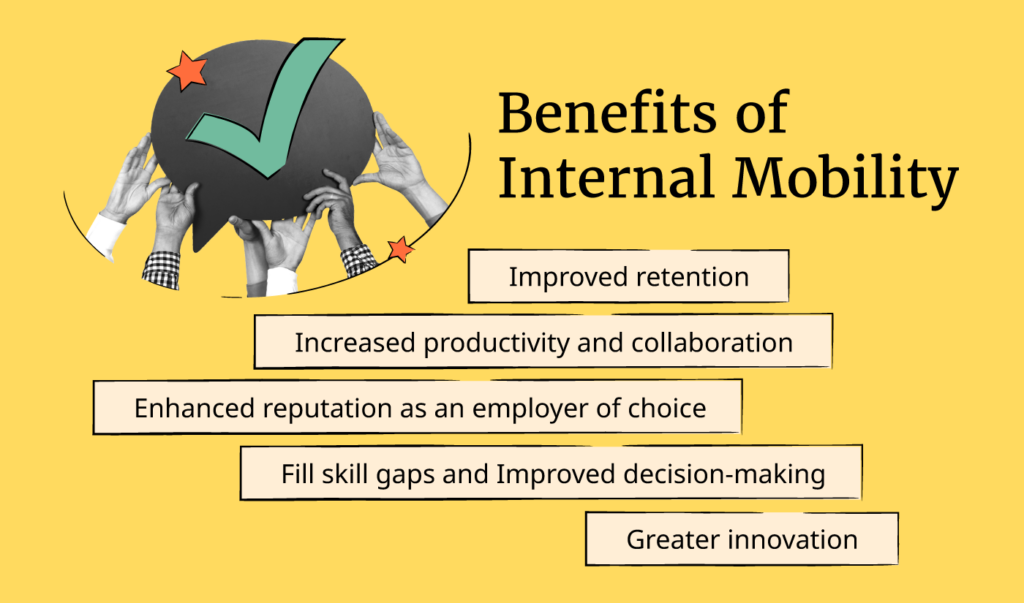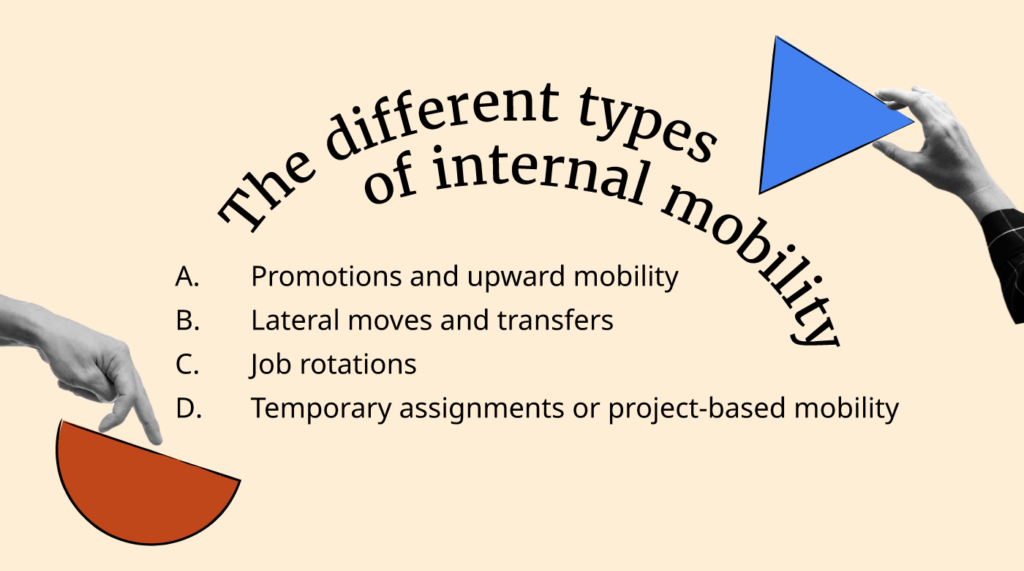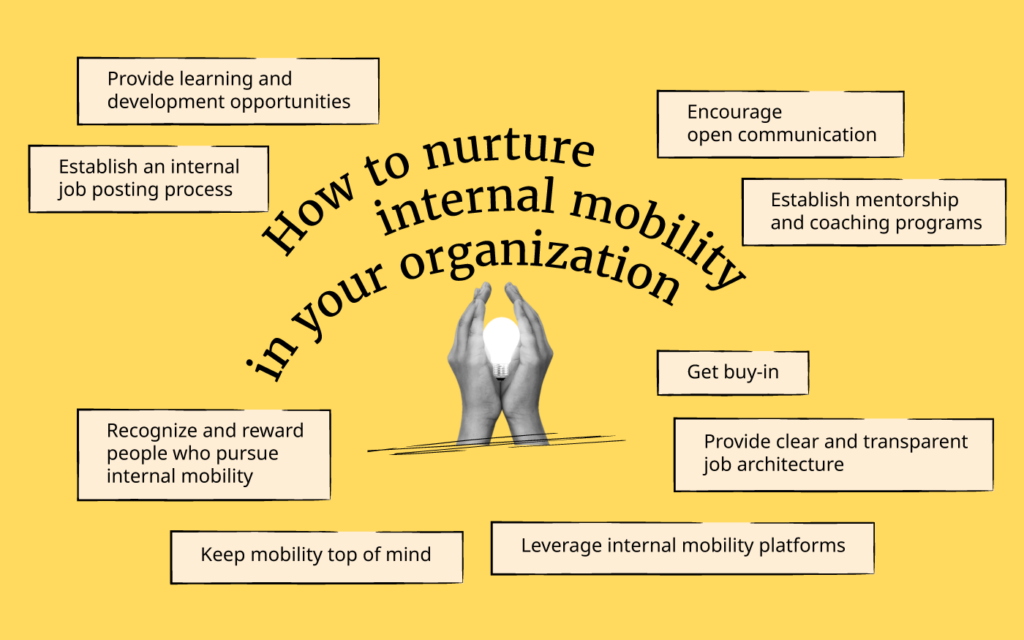Behind compensation, lack of career development and advancement opportunity is the leading cause of voluntary attrition.
This is why, if you’re concerned about keeping your employees, nurturing internal mobility is a good idea.
But that’s not all the benefits.
In this article, I’ll help demonstrate the ways internal mobility can benefit your organization and how to nurture it.
What is internal mobility?
Internal mobility refers to the movement of employees within an organization from one position to another. It can take many forms, for example promotions, lateral moves, job rotations, or temporary assignments, and can involve a change in department, team, or location.
It can also involve an employee taking on a new role or responsibility within their current department or team.
Internal mobility can be initiated by the employee themselves or by the organization. It’s an opportunity for employees to grow their skills and advance their careers within the company.
The benefits of internal mobility

Internal mobility can bring a number of benefits to both organizations and employees.
By providing workers with opportunities for career growth and development within the company, internal mobility can help improve retention rates and reduce the costs associated with hiring and training new employees.
Encouraging internal mobility can also lead to increased productivity, as employees who are given the opportunity to take on new challenges and roles learn transferable skills, are likely to be more engaged and motivated along their career path, and may even collaborate better with other departments internally.
Additionally, companies that support internal mobility and promote from within are often seen as good places to work, which can help to attract top talent and enhance the company's reputation as an employer.
Here’s a quick list of benefits with a little bit more detail to help encourage you to promote internal mobility in your organization:
- Improved retention: Internal mobility can help improve retention rates by providing employees with opportunities for career growth and development within the company. This can help reduce turnover and the associated costs of hiring and training new employees. Lack of internal mobility and career advancement opportunities are two of the top reasons employees leave organizations.
- Increased productivity and collaboration: Team members who are given the opportunity to take on new challenges and roles within the organization are likely be more engaged and motivated, leading to increased productivity. Additionally, they’ll likely build relationships across the organization, easing collaboration, especially when times are rough or emotions run high.
- Enhanced reputation as an employer of choice: Companies that support internal mobility, and promote from within, are often seen as good places to work, which can help to attract top talent and enhance the company's reputation as an employer.
- Fill skill gaps and improved decision-making: When employees are given the opportunity to take on new roles and responsibilities, they may be exposed to different parts of the organization and gain new perspectives and experiences that can build skills and inform their decision-making because they’re better informed about how the organization operates as a complete system (the so-called “T-shaped” person I’ll discuss below).
- Greater innovation: Internal mobility can help bring new ideas and approaches to the organization as employees from different departments and teams interact and collaborate with one another. Someone from marketing might have a great idea for a feature in a software product, or a support agent might know what bothers customers most and has a great idea for how to improve the UI.
Fill skill gaps and enhance decision-making with T-shaped People

Internal mobility is one of the best tools for filling skill gaps within your organization and give people the information they need to make better decisions.
Employees who have varied experiences are more well-rounded in their view of the organization, and are able to contribute at a higher level with more organizational awareness and cross-functional impact understanding which contributes to better decision making.
These well-rounded individuals are often called “T-Shaped people.”
A "T-shaped person" is a term used to describe an individual who has a depth of knowledge and expertise in a particular area (represented by the vertical stroke of the T), as well as a range of skills and knowledge in other areas (represented by the horizontal stroke of the T).
The concept of the T-shaped person was originally developed by David Guest in the 1990s as a way to describe the ideal candidate for a team-based organization.
T-shaped individuals are seen as valuable assets to organizations because they have the ability to work effectively on their own as well as collaborate with others across knowledge areas.
They have a specialized skill set that allows them to contribute to a specific area of the business, while also having the adaptability and flexibility to work on cross-functional teams and contribute to other areas of the organization.
This combination of depth and breadth of skills and knowledge makes T-shaped individuals well-rounded employees able to take on a variety of tasks and challenges. The decisions made by T-shaped employees are typically contextually-aware and consider the needs of teams across the organization rather than just their individual team.
When I’m assigned to drive a large cross-functional change, I look for T-shaped people to lead the effort because I know that their collective organizational awareness and expertise will produce the best, most effective, and thoughtful outcome.
What are the different types of internal mobility?

There are several different types of internal mobility, each with varying features. It’s likely someone will experience multiple types of internal mobility over the course of their employment.
Promotions and upward mobility
A promotion involves an employee moving up to a higher-level position within the same organization.
This can be within or outside of the employee’s current department or job family. For example, a professional services project manager might become an engineering operations manager, or a technical support agent may become a project engineer.
In both cases, employees are moving into a different department and job family. In the case of the project manager, becoming an engineering operations manager was an opportunity to lead a large, experienced team. For the support agent turn project engineer, interaction length and depth changed from transactional to relationship-based and outcome-oriented work.
These moves are very exciting for the organization as, with each move, the employee brings along the knowledge, skills, experience, and relationships from their prior role into their new role.
Better yet, if the promotion role serves, leads, or supports the prior role, the person that has been promoted will have a significant understanding of those they serve.
Lateral moves and transfers
A lateral move involves an employee switching to a different role or department within the same organization, but at the same level as their current position.
The most common lateral move I’ve seen is moving from upper levels of customer-facing support organiazations to implementation or professional services teams.
In the case of this move, the systems are the same, the work is similar, but the context and cadence of the work changes from being reactive and transactional to predictive and relationship-based.
Support agents make the best implementation specialists because they already know the product, tools, organization, and leadership and have a good understanding of what the customer needs.
Transfers within an organization help to build relationships across departments, fill skill gaps, and place people in positions where they utilize their unique skills to make the most impact.
Job rotations
A job rotation involves an employee temporarily switching to a different role or department within the same organization, typically with the goal of gaining new skills and experiences.
Job rotations are typically within a defined program, where employees rotate between different job roles over time to develop different skills and expose them to different parts of the business, which can lead to increased productivity and innovation.
Job rotations can take many forms, including short-term assignments or longer-term placements, and can be initiated by either the employee or the organization.
Temporary assignments or project-based mobility
A temporary assignment involves an employee taking on a new role or responsibility within the same organization for a limited period of time.
Temporary assignments are an incredible way for employees to try out a new role or even fill in a gap to improve help overall organizational performance.
Personally, I’ve experienced tremendous growth by participating in temporary assignments at my current org.
I was once pulled from my normal role as a program manager to be an engineering manager while someone went on sabbatical. I’ve also jumped in to run a professional services project rescue, and was pulled into merger and acquisition integration on a temporary basis at first.
Each temporary assignment taught me a significant amount about the organization, my management style, and how to influence and get things done even if I don’t have all the answers.
The challenge is typically a little daunting at first, but the feeling of figuring it out and contributing in a new way always outweighs any fears.
Pro Tip: Every employee needs to take vacation over the course of the year. What other people in your organization might be able to step up and learn a new role or contribute differently as a temporary assignment? What projects are coming up that might be a good opportunity for internal mobility?
Temporary and project-based assignments to cover employee vacations are an excellent way to challenge and grow employees, even if a promotion, transfer, or job rotation is not immediately available.
Recently, to avoid layoffs and fill skill gaps, Zapier launched a secondment program that enables underutilized recruiters to apply their skills in other areas of the business.
How to nurture internal mobility in your organization

To nurture internal mobility in your organization, start by creating a culture that values and supports it.
This involves offering training and development opportunities, encouraging open communication, establishing an internal job posting process, offering mentorship and coaching, and recognizing and rewarding employees who pursue internal mobility.
It’s also important to provide employees with clear career development paths and internal mobility programs to encourage them to take on new challenges and roles within the organization.
By fostering a culture of growth and development, you can create an environment that supports and encourages internal mobility, helping employees to advance their careers and grow with the company.
Here are a few ways you can help nurture internal mobility.
Provide learning and development opportunities
By offering employees the opportunity to learn new skills and gain new knowledge, organizations can help prepare them for new roles within the company.
This can be internal or external training, a temporary assignment on a different team or project, or even a temporary assignment serving as a leader.
I’ve seen great success in people stepping into these development opportunities, even if they return to their historical role at the end of the temporary assignment.
Related read: How To Create A Learning And Development Strategy In 7 Steps
Encourage open communication
Encouraging open communication between employees and management helps create a culture of transparency and collaboration, making it easier for employees to learn about new job opportunities and express their interest in them.
Build an environment where employees can talk with their leaders and peers about their career aspirations, learning goals, and steps to get there.
This may sound a bit out of line, but I find it's super important for managers to be invested in the growth of their employees as people, not only as employees of that specific organization.
The managers I’ve respected most genuinely cared for my well-being and overall career development. They created space for me to talk about what I want to do with my life, even if that meant not working at that same company.
This has everything to do with leadership and how you approach your employees; be intentional and if/when you do talk with your team about their aspirations, consider sharing a story of how you have partnered with a mentor or manager in a similar way.
Establish an internal job posting process
Creating a system for posting and advertising job openings internally makes it easier for employees to learn about and apply for new roles within the company.
Many organizations post roles internally at first, with a standard waiting period before posting publicly.
This way, internal employees have an opportunity to submit their applications before the inbox begins to overflow with applications.
In partnership with your talent acquisition team, determine how to conduct internal recruitment and determine how internal candidates should be treated if they apply for an open role. Do they automatically get a hiring manager interview if they meet or are close to the requirements?
In organizations I’ve been part of, any internal candidate for a role was automatically placed for a hiring manager video interview if they were close enough to the requirements (say 70-80% aligned).
This way, even if the internal candidate doesn’t get the job, they’ve networked with the hiring manager and received feedback about what they can do to prepare for a new role in the future.
For example, it's hard to get experience as a product owner without being one; but the best product owners I’ve seen were promoted via internal mobility, and their deep knowledge of the product, market, and customer needs made them the best at what they do.
In the case of the product owners, internal candidates already had at least 70% of the knowledge to do the job, and teaching the rest was simple given the relationships and existing awareness of the organization they already had.
Establish mentorship and coaching programs
Providing employees with the support of a mentor or coach can help them develop the skills and confidence they need to take on new challenges within the organization.
Mentorship programs are one of the best tools to build leadership and support diversity among leadership teams.
In my company, I facilitate a formal mentorship program twice a year with up to 100 mentees learning new skills from top leaders in the organization.
Over time, we’ve observed that those who engage in mentorship, both the mentor and the mentee, are more likely to experience career development.
Related read: How To Start An Effective Mentoring Program In 6 Steps
Recognize and reward people who pursue internal mobility
By recognizing and rewarding those who take on new roles or responsibilities within the organization, companies can encourage others to follow suit.
Mentors can help with this by connecting their mentees to opportunities they’re aware of within the organization and suggesting next steps to achieving the mentee’s goals.
The mentor is not to do anything specific for the mentee, but they can guide the mentee in their own actions and make connections to opportunities for the mentee to pursue.
A quick note on mentorship vs. sponsorship. To sponsor an employee is to advocate for them behind closed doors. Mentorship doesn’t include advocation on behalf of the mentee, but gives the mentee tools and a few connections to advocate for themselves.
Get buy-in
To effectively leverage internal talent mobility and reap the rewards, everyone in the organization needs to be informed and on board for promoting internal employee development.
This can be achieved by educating people across your organization about its benefits.
A great way to do this is by sharing success stories of those who have benefitted from internal mobility, including their experiences and the impact it has had both on the employee’s career and the organization as a whole.
Provide clear and transparent job architecture
How are people supposed to move around if they don’t know what opportunities are out there?
In my organization, the requirements of each job are clearly spelled out and career paths are defined. This information is shared transparently across the organization.
Every employee can see the requirements and job descriptions of every role, and can chart the path towards competence and preparation for their next role in the organization, no matter what it might be.
This takes a bit of work to setup at the outset, but knowing what’s there, what’s next and what other options are available is immensely valuable!
Keep mobility top of mind
Ultimately, each individual is responsible for their own career development. Managers can coach employees to seek new opportunities within the organization, but each individual must be self-motivated to take on new challenges and grow towards their unique career goals.
That said, team members can benefit from training sessions about career mapping, upskilling, finding internal opportunities, and reskilling to new roles.
Also, career advancement and career mobility should be top of mind for all managers when conducting performance reviews.
Managers and employees alike should always be on the lookout for learning opportunities that can help existing people prepare to meet business needs by shifting into new positions, working on new initiatives, and building the internal talent pool.
Leverage internal mobility platforms
The most prepared organizations leverage tools to encourage internal mobility. A popular example is an internal talent marketplace.
These are highly connected, intelligent, and transparent talent management systems within your organization.
They’re designed to make it easier for talent to move around an organization by connecting them to new growth opportunities based on their skill sets, interests, and the needs of the business.
Related read: How to build an internal talent marketplace.
Let’s get movin’!
By nurturing internal mobility, you can improve retention rates, increase productivity, enhance your reputation as an employer, improve decision-making, and foster greater innovation.
You’ll also get the warm fuzzing feeling that comes from watching people grow in their careers!
Have you moved around within an organization? That’s internal mobility! Share your experiences with me in the comments and we can learn together. What’s worked? What could have been done better? I want to know!
Also, if you found this article useful, subscribe to the People Managing People newsletter to receive all our latest expert articles on talent management and development.


